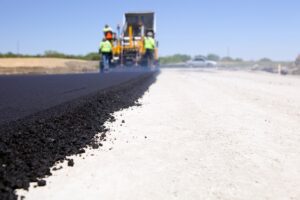If you want to install asphalt pavement or repave an area with asphalt, you should understand the process involves more time than just laying the material in the designated space. Paving contractors will prepare a sub-base along with a binder and then lay down an asphalt surface.
After the final roll over the asphalt ensures a smooth and durable finish, the asphalt is not ready to use yet. It must dry thoroughly to allow the material to settle and function at its strongest. Otherwise, the pavement might form depressions and be more susceptible to cracking or other structural damage.
Therefore, you must follow guidelines from the pavers to allow the asphalt to dry adequately. Read on to learn more about the drying process required for proper asphalt installation.

How Long Does Asphalt Take to Dry?
Asphalt features a blend of stone and gravel bound by cement, and pavers lay it into place while it is heated and malleable. It will take some time for this asphalt mixture to harden into the pavement you are familiar with.
Paving experts determine that this drying process lasts for 24 to 72 hours. In the meantime, you should not allow traffic on the pavement. You can allow pedestrians to walk on this type of pavement within the first day of the asphalt installation.
The curing process differs from drying. This refers to the time it takes for the asphalt to fully harden from a pliable material. Though you can allow vehicles to drive over the pavement before this time, you should avoid parking in the same spot or placing heavy items on the asphalt.
This could create a risk of making depressions in the asphalt, ruining its smooth finish. Curing will take 90 to 180 days to fully complete. Paving contractors will not be able to seal coat the asphalt until it is cured, so the asphalt installation process will last longer than you might guess.
Does Weather Impact Asphalt Drying?
The drying process of asphalt pavement is not completely exact. Certain factors, especially when it comes to weather, can make it take longer or shorter to dry asphalt. Humidity in the air can play a major role in the paving process.
With more moisture in the air, it will be less likely to absorb from elsewhere, leading to increased drying times for your pavement. Higher temperatures will encourage the evaporation process to cut the time needed to dry asphalt. But if it is too hot, the application of the asphalt could be impeded.
Sunny weather will also help to reduce the drying time of your new asphalt. Whereas rainy weather could ruin your asphalt. Schedule your paving project to ensure at least 24 hours of dry weather after installation.
Breezy weather can also make for better conditions for evaporation and therefore drying. But harsh weather could hinder the paving process. If you worry about your ability to allow the pavement to dry properly, call your local paving company.
